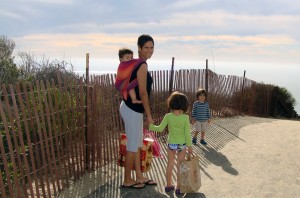My son Jacob is 22 months old. He loves to run and climb and jump and throw balls and all those things that toddlers do. He is no longer the babe in arms that he was for the first months of my life, carried from place to place by others. Today, he motors under his own steam and heads in his own direction.
I have been practicing babywearing with Jacob since he was a few days old. He is my second child – his big sister Hannah is 3 1/2 years older than he is. Babywearing was one of the tricks in my parenting toolbag that helped me meet the needs of both children. When Jacob was small he was frequently worn in a sling or mei tai as I took Hannah to the library or to the park. He came along for the ride wherever we went and I was like a walking billboard for babywearing.
 I still wear Jacob regularly. It’s not the same as when he was little, of course. These days he’s not content to nap on my back while his big sister plays on the playground. He wants to get down and engage with the world. But when he’s having a hard time falling asleep, or when he needs to nap while I do other things, babywearing saves the day. Secure in the carrier he sleeps better than most anywhere else. And I know exactly where he is, and feel confident that he is safe and comfortable.
I still wear Jacob regularly. It’s not the same as when he was little, of course. These days he’s not content to nap on my back while his big sister plays on the playground. He wants to get down and engage with the world. But when he’s having a hard time falling asleep, or when he needs to nap while I do other things, babywearing saves the day. Secure in the carrier he sleeps better than most anywhere else. And I know exactly where he is, and feel confident that he is safe and comfortable.
There are some tricks to wearing a toddler. Having a sturdy baby carrier that will safely bear your child’s weight is always important, but your options change as your child gets bigger. An exuberant toddler can really wiggle, so you have to make sure they’re secure enough that they won’t fall out when they suddenly decide to throw themselves to the left. You’re also working around a much bigger child, not a small bundle curled up in a sling – which is why I usually put Jacob on my back.
Babywearing hasn’t become uncomfortable for me as Jacob’s grown bigger. Sure, carrying 25 extra pounds around can be tiring. I feel it in my legs when I crouch down and stand back up. But with a good carrier that distributes weight well and fits me properly, I don’t find it painful. My back and shoulders don’t hurt, and I am able to wear Jacob far more easily than I could carry him in my arms.
As my daughter Hannah moved through toddlerhood, she drifted away from babywearing and returned several times. Just when I thought we were really and truly done, she’d pull out her favorite carrier and ask me to put her in it. I expect the same thing may happen with Jacob, as well. Some days he may want to walk, some days he may want to be worn, some days he won’t be able to make up his mind. But as long as he needs me and I am able I will be here, ready to wear him.
Have you worn a toddler? How did you make it work – or not? I’d love to hear your tips, tricks and stories!
You can catch up with Amber’s adventures in parenting and babywearing on her blog at Strocel.com.

 questions and more become so much clearer once you know the basic carrier types. There are six basic types of carriers. They are woven wraps, stretchy wraps, ring slings, pouches, mei tais and buckle carriers.
questions and more become so much clearer once you know the basic carrier types. There are six basic types of carriers. They are woven wraps, stretchy wraps, ring slings, pouches, mei tais and buckle carriers.

